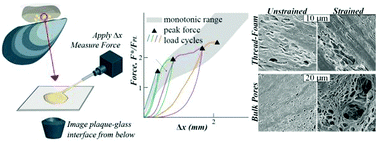Influence of multi-cycle loading on the structure and mechanics of marine mussel plaques†
Abstract
The proteinaceous byssal plaque–thread structures created by marine mussels exhibit extraordinary load-bearing capability. Although the nanoscopic protein interactions that support interfacial adhesion are increasingly understood, major mechanistic questions about how mussel plaques maintain toughness on supramolecular scales remain unanswered. This study explores the mechanical properties of whole mussel plaques subjected to repetitive loading cycles, with varied recovery times. Mechanical measurements were complemented with scanning electron microscopy to investigate strain-induced structural changes after yield. Multicyclic loading of plaques decreases their low-strain stiffness and introduces irreversible, strain-dependent plastic damage within the plaque microstructure. However, strain history does not compromise critical strength or maximum extension compared with plaques monotonically loaded to failure. These results suggest that a multiplicity of force transfer mechanisms between the thread and plaque–substrate interface allow the plaque–thread structure to accommodate a wide range of extensions as it continues to bear load. This improved understanding of the mussel system at micron-to-millimeter lengthscales offers strategies for including similar fail-safe mechanisms in the design of soft, tough and resilient synthetic structures.



 Please wait while we load your content...
Please wait while we load your content...